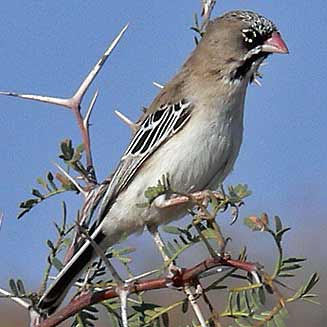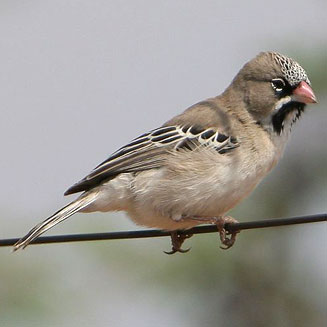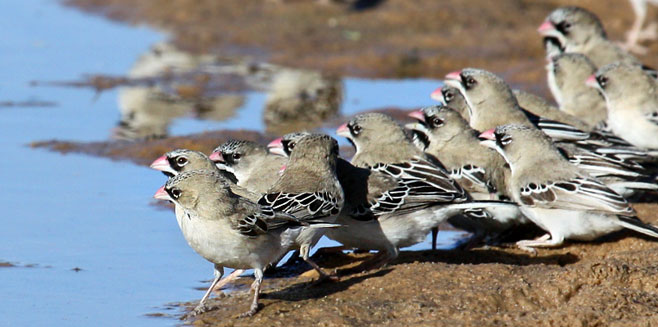|
Sporopipes squamifrons
(Scaly-feathered finch)
Baardmannetjie [Afrikaans]; Thaga (also applied to
Village weaver) [North Sotho]; Letsetsenkana, Raêuwanêng [Tswana];
baardmanwever [Dutch]; Sporopipe squameux [French]; Schnurrbärtchen
[German]; Tecelão-de-testa-malhada [Portuguese]
Life
> Eukaryotes >
Opisthokonta
> Metazoa (animals) >
Bilateria >
Deuterostomia > Chordata >
Craniata > Vertebrata (vertebrates) > Gnathostomata (jawed
vertebrates) > Teleostomi (teleost fish) > Osteichthyes (bony fish) > Class:
Sarcopterygii (lobe-finned
fish) > Stegocephalia (terrestrial
vertebrates) > Tetrapoda
(four-legged vertebrates) > Reptiliomorpha > Amniota >
Reptilia (reptiles) >
Romeriida > Diapsida > Archosauromorpha > Archosauria >
Dinosauria
(dinosaurs) > Saurischia > Theropoda (bipedal predatory dinosaurs) >
Coelurosauria > Maniraptora > Aves
(birds) > Order: Passeriformes
> Family: Ploceidae
 |
 |
|
Scaly-feathered finch. [photo
Lorinda Steenkamp
©] |
Scaly-feathered finch, Tswalu Kalahari Reserve,
South Africa. [photo Trevor Hardaker ©] |
 |
|
Scaly-feathered finch flock, Kgalagadi
Transfrontier National Park, South Africa. [photo
Lorinda Steenkamp
©] |
Distribution and habitat
Near-endemic to southern Africa, occurring from Zimbabwe
and northern South Africa to Botswana, Namibia and the south-western Angola. It
generally prefers dry Acacia woodland with scattered small trees, also in
bushy vegetation along seasonal rivers, farmyards and suburban gardens.
|
 |
|
Distribution of Scaly-throated finch in southern Africa,
based on statistical smoothing of the records from first SA Bird Atlas
Project (©
Animal Demography unit, University of
Cape Town; smoothing by Birgit Erni and Francesca Little). Colours range
from dark blue (most common) through to yellow (least common).
See here for the latest distribution
from the SABAP2. |
Predators and parasites
It (at different stages of development) has been recorded
as prey of the following animals:
- Adults
- Eggs and chicks
- Acanthoplus (armoured bush crickets)
Food
It mainly eats the seeds of grasses (including Aristida
and Schmidtia) supplemented with insects such as termites, doing most
of its foraging on the ground.
Breeding
- Monogamous, usually solitary nester, although multiple nests may
occasionally be clustered in a small area.
- The nest is a hollow ball made of dry grass stems and inflorescences
with a short entrance tunnel, while the interior is lined with fine grass
flowers. It often uses the stems and attached flowers of the aromatic
Pentzia plant, possibly because the smell repulses ectoparasites. It is
typically placed in the thin branches of a thorny tree or bush, sometimes
conjoining with an old flycatcher, shrike or weaver nest.
- Egg-laying season is year round, peaking from about December-June.
- It lays 2-7 eggs, which are incubated for about 10-12 days.
- Little is known about the chicks, other then that they leave the nest
after about 14-18 days.
Threats
Not threatened.
References
-
Hockey PAR, Dean WRJ and Ryan PG 2005. Roberts
- Birds of southern Africa, VIIth ed. The Trustees of the John Voelcker
Bird Book Fund, Cape Town.
|
